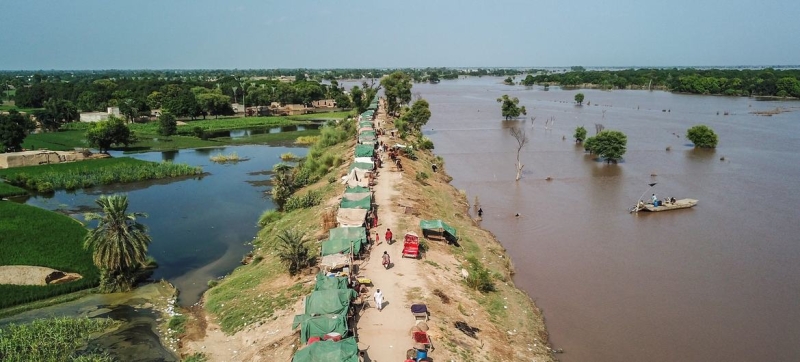
Consequences of floods in Pakistan. Photo from the archive UN: Developing countries will need $310 billion a year to adapt to climate change impacts Climate and Environment
As global temperatures rise and the impacts of climate change worsen, the huge gap in adaptation financing for developing countries is putting lives, livelihoods and entire economies at risk. This is stated in the report on climate change adaptation measures for 2025. The study, entitled “Fuel Running Out,” was prepared by the United Nations Environment Program (UNEP).
A report released to inform negotiators at the UN Climate Change Conference (COP 30) in November in Belém, Brazil, finds that despite improvements in adaptation planning and implementation, adaptation financing needs in developing countries will exceed $310 billion a year by 2035, 12 times higher than current international public funding for adaptation. adaptation.
“The impact of climate change is accelerating. But adaptation funding has not kept pace, leaving the world’s most vulnerable people suffering from rising sea levels, deadly storms and sweltering heat, UN Secretary-General Antonio Guterres said in a message marking the report’s release. – Adaptation is not an expense, it is a means of salvation. Closing the gap on climate change adaptation is how we protect lives, achieve climate justice, and build a safer, more resilient world. There is not a minute to lose.”
Adaptation is not an expense, it is a means of salvation
“Every person on this planet faces the consequences of climate change: wildfires, extreme heat, desertification, floods, rising prices and much more,” said Inger Andersen, Executive Director of UNEP. “As efforts to reduce greenhouse gas emissions continue to lag, these impacts will only get worse, harming more people and causing significant economic damage. We need a global effort to increase adaptation financing – from both public and private sources – without increasing the debt burden of vulnerable countries. Even with tight budgets and competing priorities, the reality is simple: If we don’t start investing in adaptation now, we will face rising costs every year.”
Gaps
The estimate of $310 billion needed to finance adaptation in developing countries by 2035 is based on modeled costs. If estimates are based on extrapolated needs reflected in Nationally Determined Contributions and National Adaptation Plans, this figure rises to US$365 billion. These numbers are based on 2023 data and are not adjusted for inflation.
If we don’t start investing in adaptation now, we will face rising costs every year
International government adaptation finance flows to developing countries totaled $26 billion in 2023, down from the previous year’s $28 billion. This puts the adaptation financing gap at $284-339 billion per year, 12-14 times higher than current flows. The Climate Adaptation Gap Report’s previous estimate was $194-$366 billion for 2030.
If current funding trends do not change in the near future, the target of doubling international public funding for adaptation from 2019 levels to around $40 billion by 2025, as set out in the Glasgow Climate Action Framework pact, will not be implemented.
Planning and implementation of measures
About 172 countries have at least one national adaptation policy, strategy or plan; only four countries have not yet started developing a plan. However, in 36 of the 172 countries, the tools were out of date or had not been updated in at least a decade. This must be taken into account to minimize the likelihood of incorrect adaptation.
In the Biennial Transparency Reports submitted under the Paris Agreement to describe progress towards meeting climate commitments, countries reported more than 1,600 adaptation measures implemented, mostly in the areas of biodiversity, agriculture, water and infrastructure. However, few countries report the actual results and impacts needed to evaluate their effectiveness.
Meanwhile, support for new projects under the Adaptation Fund, the Global Environment Facility and the Green Climate Fund has grown to almost $920 million in 2024. That’s an 86 percent increase over the five-year average of $494 million between 2019 and 2023. However, this may only be a temporary blip as emerging financial constraints make the future uncertain.
Increasing public and private financing
A new collective quantified climate finance target agreed at COP29 calls for developed countries to commit at least $300 billion a year to combat climate change climate change in developing countries by 2035. This is not enough to close the funding gap for two reasons.
First, if the inflation rate of the last decade continues until 2035, the estimated adaptation financing needs of developing countries will increase from $310–365 billion per year in 2023 prices to $440–520 billion per year. Second, the $300 billion target is for both mitigation and adaptation, meaning that a smaller share will be allocated to adaptation.
The Baku-Belen roadmap to raise $1.3 trillion by 2035 could make a huge difference, but care must be taken not to increase the vulnerability of developing countries. Grants, concessional and debt-free instruments are critical to preventing the build-up of debt that would hamper vulnerable countries’ investment in adaptation.
For the roadmap to work, the international community must reduce the adaptation finance gap through mitigation and prevent maladaptation, increase financing through new providers and instruments, and engage more financial actors to integrate climate resilience into financial policymaking. solutions.
While the private sector must do more, the report estimates the realistic potential for private investment in national government adaptation priorities at $50 billion per year. By comparison, private investment currently stands at about $5 billion a year. Achieving $50 billion will require targeted policy action and a combination of financing solutions, with concessional public financing used to reduce risk and increase private investment.
